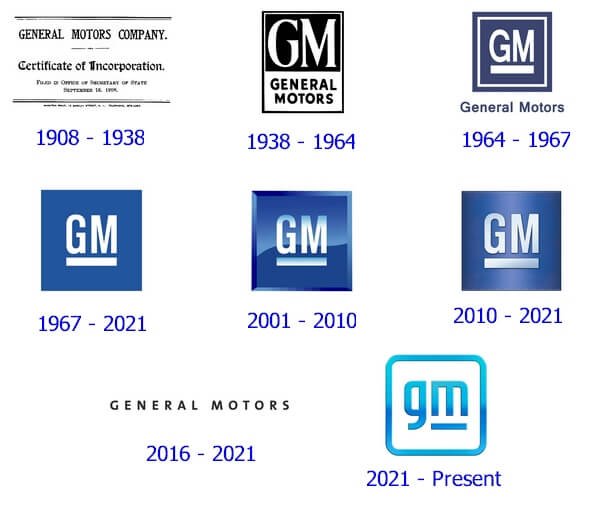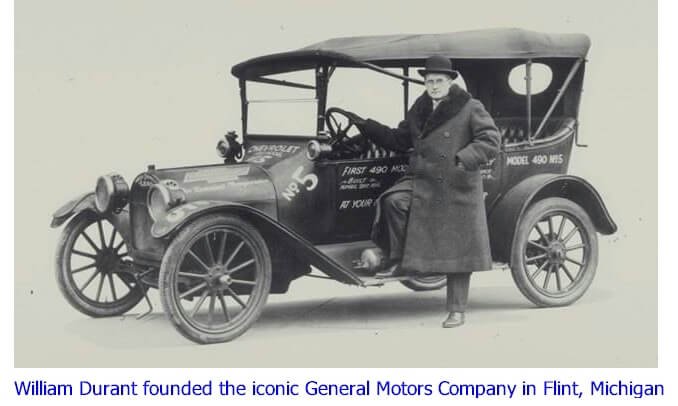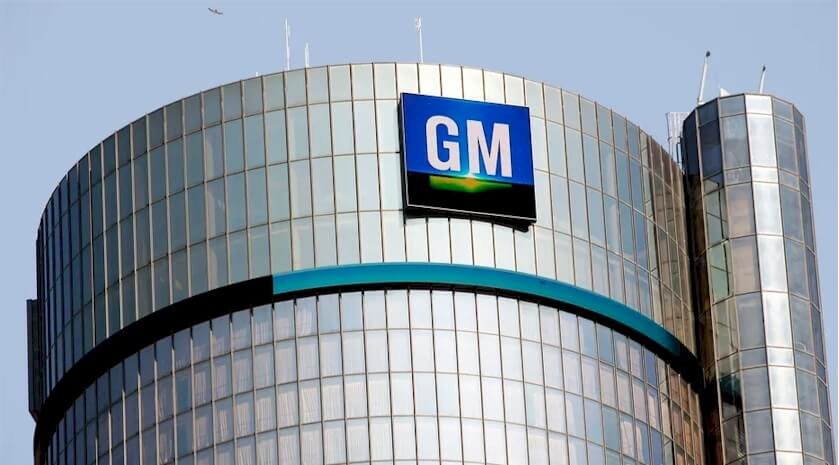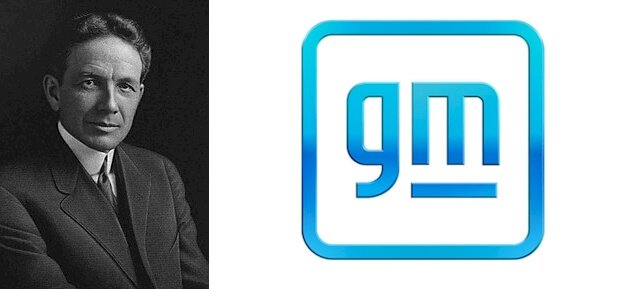The General Motors (GM) “Mark of Excellence” emblem is widely considered one of the most instantly recognizable and memorable vehicle logos of all time. While blue in the logo portrays the excellence and reliability of GM, white depicts its purity, integrity, and charm.
The current GM logo was created by GM’s graphic designer Bianca Iacopelli. She comes from a lineage of artists. While her mother is a reasonably well-known illustrator, her grandfather is a gifted sculptor and painter. Iacopelli, 29, began drawing at the age of 5 and, considering her genes, found her calling quite early.
In early 2021, GM announced that after well over 50 years, the company would change the impressive, iconic GM logo. The current GM symbol reflects the automaker’s move into the electric vehicle world.
The letter “M” has a brighter sky blue appearance in this new logo and is portrayed as an electric cord plug. This is done tastefully to represent the company moving forward and looking into the future. Moreover, the new logo is combined with a new promotional campaign dubbed “Everybody In.”
The GM Logo Evolution

The General Motors logo is famous for its conciseness and simplicity. As one of the most memorable and most recognizable motor vehicle logos ever, GM’s visual identity has helped the company record-high sales over the years. Here’s how the GM logo has evolved throughout its history.
1908 – 1938
The original GM logo was designed in 1908 and was very simple during the early years of the company’s existence. Instead of a graphic symbol, it resembled an information plate with essential information such as the name, registration date, year of foundation, and so on. The logo was written in black letters against a white backdrop.
1938 – 1964
In 1938, General Motors got its first real logo design, and it was a double-color vertical rectangle with two sections.
The upper larger section contained the logotype “GM,” an acronym for the company’s full name. The letters were huge and elegant and were written in serif-type font and painted white against a black background.
On the other hand, the smaller lower section contained “General Motors” in black, written in uppercase in two lines. This wordmark was written in a more contemporary and smooth sans-serif font, balancing the classic style of the emblem.
This logo design was laconic and minimalist, which portrayed a powerful automaker company and brought a sense of stability and authority to mind.
1964-1967
GM’s first real logo was redesigned for the first time in 1964. The designers went for the acronym “GM” in the updated version and shifted the full name outside the square.
The acronym “GM” was in the middle of a square that had two borders of alternating blue and white stripes. The designers used a different font for the acronym: the serifs were removed, and a “G” curly feature was added at the bottom.
1967 – 2001
The General Motors logo was redesigned for the third time in 1967. It got more minimalistic and even more straightforward. It was a blue square featuring rounded angles and a white underlined “GM” wordmark on it. This wordmark consisted of only “GM” lettering, written in a classic Helvetica font.
1967 – 2001
The logo design of this era was used for quite a long time. As the designers got rid of most of the elements, this design was very simple. All that was left was the acronym and the white underline below it against a blue background. Also, the designers removed the borders of the square.
2001-2010
GM introduced a new logo design in 2001—a glossy version of the emblem used since 1967. This design consisted of a 3D frame that looked like a ledge with borders. A horizontal wave was featured in the middle against “GM’s” background, splitting the logo into two sections. A gradient is featured in both the background and letters.
2010-2021
The designers gave the emblem a metallic shade and increased the 3D effect in 2001. Due to the reorganization of highlights and shadows, the logo received some volume. While the color was toned down, the gradient stayed put both on the square and letters.
2011-2021
In addition, General Motors used a more basic wordmark. The brand’s full name was written in a low-key sans font with vaguely rounded corners.
2021-Present
General Motors substantially changed its logo design for the first time in almost 60 years, focusing on the latest technology and sustainability. The automaker tried to highlight its focus on manufacturing electric vehicles with its emblem. The new version has the acronym “GM” written in lowercase letters and placed in a square with rounded corners.
This super-soft design featuring a white and blue color scheme emphasizes the car maker’s desire to preserve the environment by protecting the air, clouds, and sky. The designers depicted the letter “m” as an electrical cord plug.
In addition, below the letters is an underline that represents an impromptu socket. Next to the letter “m,” there’s the letter “g” with a shortened tail, which appears harmonious in height.
The GM Logo Design Elements

Color: The GM logo has always used a standard color scheme. It has always been a combination of blue and white, the tones of which were often changed. The original version used a black and white color scheme.
Font: The main font for the “GM” acronym is a san-serif font type known as Gothic FB Cond Medium. It features straight letters as well as a curvy “G” below to visually give it stability.
The History of GM
The General Motors Company, commonly known as General Motors (GM), is an American vehicle manufacturer that was the largest carmaker globally for most of the 1900s and early 2000s.
It runs production and assembly plants and distribution centers all over the US, Canada, and numerous other countries worldwide. General Motors’ main products include trucks and automobiles, engines, and automotive components. Headquartered in Detroit, Michigan, the company is also involved in providing financial services.
Early History

General Motors was established as General Motors Company in 1908 under William C. Durant’s leadership to consolidate several motorcar companies manufacturing Buick, Cadillac, Oldsmobile, Oakland (later Pontiac), Marquette, Ewing, and other vehicles, as well as Rapid and Reliance trucks.
GM commercially launched the electric self-starter in its Cadillac version of 1912, which soon rendered the hand crank outmoded. GM’s headquarters remained in Detroit, Michigan, and the firm was reincorporated in 1916 and renamed General Motors Corporation. In 1918, Delco Products and Chevrolet joined General Motors. A year later, Frigidaire and the Fisher Body Company followed suit (the former was taken over in 1979).
In 1929, Durant was ousted out of GM and Alfred P. Sloan, Jnr. took over. He served as the company’s president between 1923 and 1937 and later as Chairman between 1937 and 1956. Sloan restructured General Motors from a confused, uncoordinated group of business entities into one enterprise made up of five major automotive divisions—Buick, Cadillac, Chevrolet, Oldsmobile, and Pontiac—whose activities were run by a central company office equipped with substantial financial and advisory employees.
The various automotive divisions retained a great deal of independence within an overall policy framework. The decentralized idea of management was soon adopted by large-scale industrial companies in the US. Sloan also substantially strengthened General Motors’ sales organization, initiated annual style car model changes, and introduced changes in consumer financing.
General Motors had overtaken Ford to become the number one passenger car manufacturer in the US by 1929. It added operations overseas, including England’s Vauxhall in 1925, Germany’s Adam Opel in 1929, and Australia’s Holden in 1931.
One of the new GM divisions and subsidiaries in the United States was the Yellow Truck and Coach Manufacturing Company (presently GMC Truck and Coach Division) in 1925. In 1931, General Motors became the largest producer of motor vehicles in the world. By 1944, 44% of cars made in the US were from GM, becoming one of the world’s largest industrial corporations.
Throughout the 1950s and 1960, General Motors grew alongside the US economy and enjoyed a 40%-45% share of the total automotive sales in the US. In 1984, GM acquired a major data processing company named Electronic Data Systems and then bought Hughes Aircraft Co., a communication satellites and weapon systems manufacturer, in 1986.
Alongside other automobile manufacturers in the US, General Motors faced increasingly stiff competition from Japanese vehicle manufacturers throughout the 1970s and 1980s. Therefore, in 1984, GM launched a new vehicle division named Saturn that made use of highly automated factories to manufacture subcompact cars to take on Japanese imports.
Although General Motors’ modernization efforts bore some fruit, massive losses at the beginning of the 1990s forced the automaker to shut down many plants and lay off tens of thousands of its employees.
GM had made a strong recovery by the mid-1990s and refocused on its automotive businesses like other US automakers. In 1996, the company sold Electronic Data Systems and then followed this up by selling its Hughes Electronics defense units in 1997, thus exiting the defense-aerospace and computer services field to focus on its car-making businesses.
In 2000, GM fully acquired Saab Automobile AB. By the early 2000s, GM had a stake in several car manufacturing companies, including Fiat, Subaru, Suzuki, and Isuzu. However, the company ditched the Oldsmobile brand in 2004. In 2008, Toyota Motor Corporation surpassed GM as the largest automaker in the world.
GM’s Bankruptcy and Bailout

By 2008, the “Big Three” automakers—General Motors, Ford, and Chrysler LLC—were struggling financially. Thus, in December the same year, President George W. Bush revealed that there was an emergency monetary rescue program in-store to bail out the automakers and prevent the demise of America’s struggling automotive industry.
The plan immediately made $13.4 billion government loans available to the automakers. The loans would enable the automakers to continue running until March 2009, when the program required them to prove their “financial viability” or give back the loan within 30 days.
In addition, the companies were required to go through restructuring. The government loan was initially offered to Chrysler LLC and General Motors; Ford claimed it had enough funds to keep going and therefore didn’t apply for the government loan.
As GM’s financial woes escalated, the automaker claimed to be in debt to the tune of a whopping $173 billion. As such, in June 2009, the company filed for bankruptcy protection. It bounced back from bankruptcy restructuring just a month later.
In 2010, General Motors sold Saab Automobile AB and officially terminated both the Saturn and Pontiac brands. The downsizing left the company with four automotive divisions: GMC, Chevrolet, Cadillac, and Buick. In November of the same year, GM initiated one of the biggest IPOs in American history. And in 2011, General Motors reclaimed its position as the world’s number one automaker.
However, General Motors’ strong recovery suffered a blow in 2014 when details emerged of the company glossing over the fact that many GM car models had defective ignition switches; the faulty component was believed to have caused over 120 deaths.
General Motors was widely praised for its management of the scandal, and the company posted impressive revenues, with record sales posted between 2014 and 2016. Its European division kept struggling, however, and Vauxhall and Opel were sold in 2017 to the French maker of Citroen and Peugeot cars, the PSA Group.
The deal, which was worth over $2 billion, was considered as the end of General Motors’ European operations.
Summing Up the History of GM
General Motors Company, widely known as General Motors, is a United States multinational corporation that designs, makes, sells, and distributes motor vehicles and their parts and sells financial services.
Founded in Flint, Michigan, in 1908, General Motors is based in Detroit, Michigan, and employs at least 284,000 people worldwide. The company makes its vehicles in 33 different nations around the world.
In 2009, GM produced over 9 million cars and trucks worldwide under brands such as Buick, GMC, Cadillac, Chevrolet, Hummer, Holden, Pontiac, Opel, Saturn, Vauxhall, and Saab.
GM has a majority stake in South Korea’s GM Daewoo Auto and Technology and has shared ventures in manufacturing and technology with several automakers around the world.







